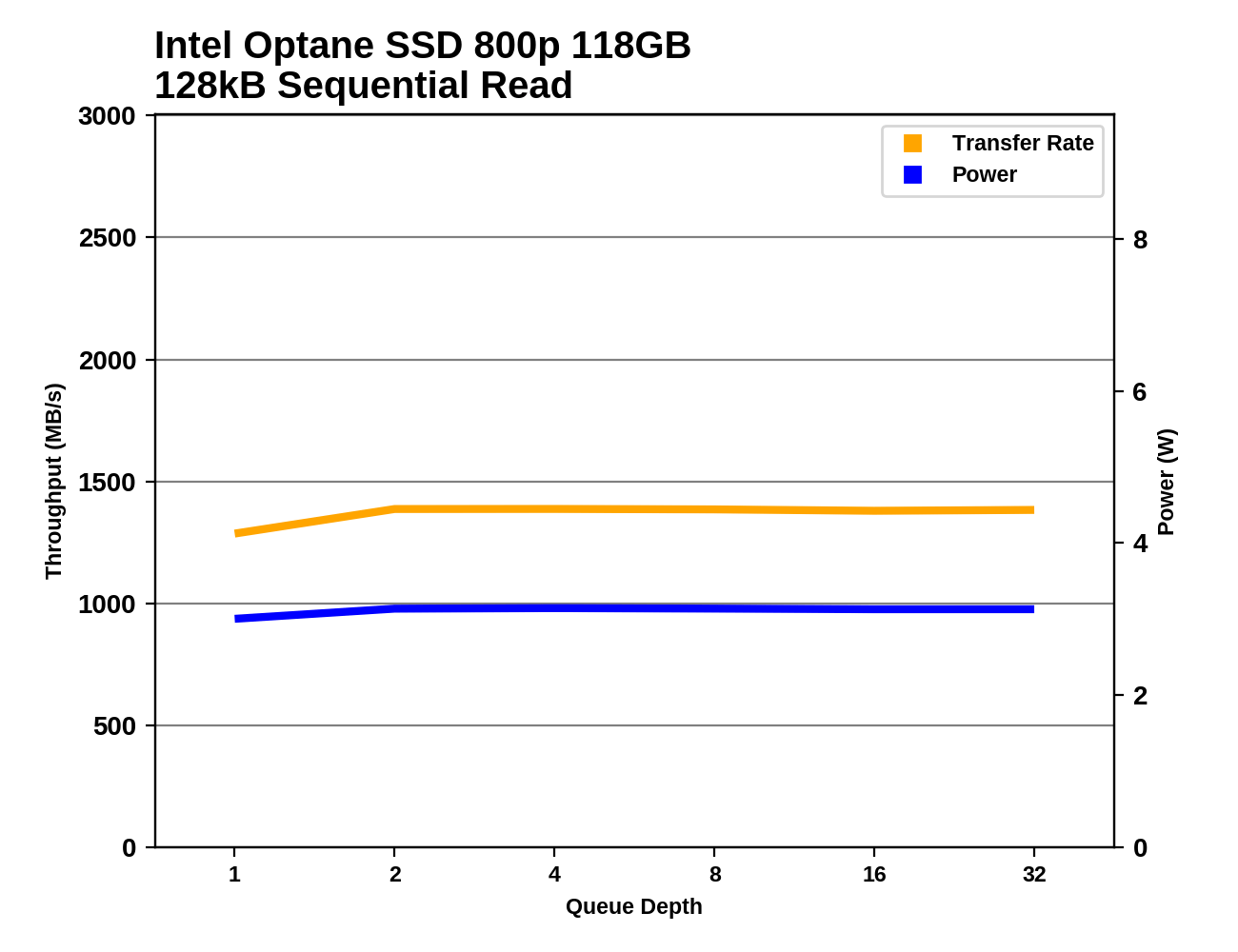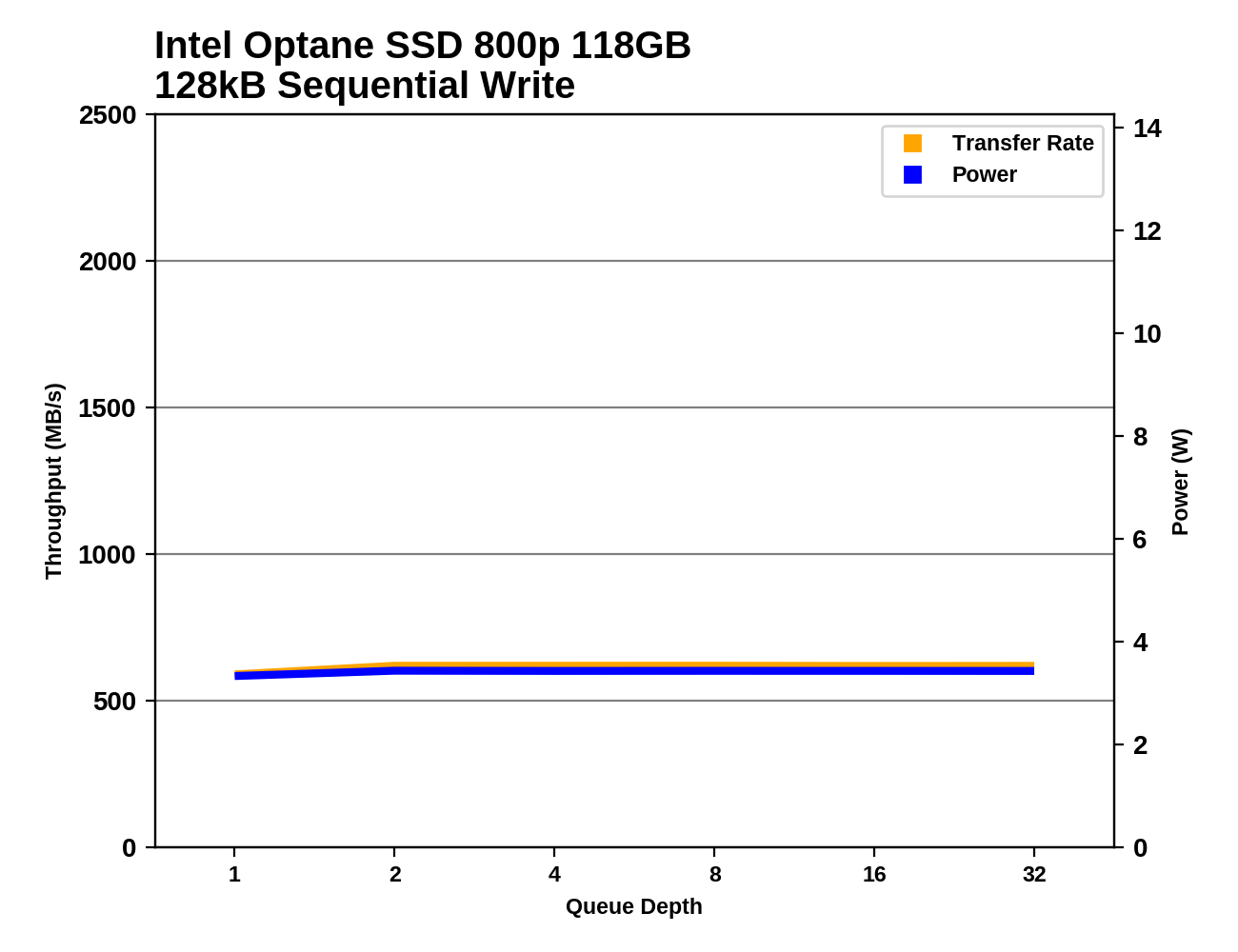The Intel Optane SSD 800p (58GB & 118GB) Review: Almost The Right Size
by Billy Tallis on March 8, 2018 5:15 PM ESTSequential Read Performance
Our first test of sequential read performance uses short bursts of 128MB, issued as 128kB operations with no queuing. The test averages performance across eight bursts for a total of 1GB of data transferred from a drive containing 16GB of data. Between each burst the drive is given enough idle time to keep the overall duty cycle at 20%.

The QD1 burst sequential read performance of the Intel Optane SSD 800p is close to their rated maximum throughput, but they are far behind the 900p and high-end Samsung drives that actually need more than two PCIe lanes.
Our test of sustained sequential reads uses queue depths from 1 to 32, with the performance and power scores computed as the average of QD1, QD2 and QD4. Each queue depth is tested for up to one minute or 32GB transferred, from a drive containing 64GB of data.

On the longer sequential read test, the Samsung NVMe SSDs fall down to the level of the Optane SSD 800p, because the flash-based SSDs are slowed down by some of the data fragmentation left over from the random write test. The Optane SSDs performed those writes as in-place modifications and thus didn't incur any fragmentation. This leaves the Samsung 960 PRO 2TB barely faster than the 800p, while the 900p runs away with its lead.

The Optane SSD 800p has the clear lead in power efficiency, as its second-tier performance comes with far lower power consumption than the top-performing 900p.
 |
|||||||||
There are no big surprises with the queue depth scaling; the 800p's sequential reads are slightly faster at QD2 than QD1, but there's no further improvement beyond that. The 800p is easily staying within its 3.75 W rated maximum power draw.
Sequential Write Performance
Our test of sequential write burst performance is structured identically to the sequential read burst performance test save for the direction of the data transfer. Each burst writes 128MB as 128kB operations issued at QD1, for a total of 1GB of data written to a drive containing 16GB of data.

The burst sequential write speed of the Intel Optane SSD 800p is no better than the low-end flash-based NVMe SSDs. Without any write caching mechanism in the controller, the fundamental nature of 3D XPoint write speeds shows through. The 900p overcomes this by using a 7-channel controller, but that design doesn't fit within the M.2 form factor.
Our test of sustained sequential writes is structured identically to our sustained sequential read test, save for the direction of the data transfers. Queue depths range from 1 to 32 and each queue depth is tested for up to one minute or 32GB, followed by up to one minute of idle time for the drive to cool off and perform garbage collection. The test is confined to a 64GB span of the drive.

The Optane SSD 800p looks better on the sustained sequential write test, as all the TLC-based SSDs run out of SLC cache and slow down dramatically, while the Optane SSDs keep delivering the exact same performance.

Despite their very different sequential write throughput, the Optane SSD 900p and 800p end up with very similar power efficiency on this test. The Samsung NVMe drives are even more efficient, but only the premium MLC-based 960 PRO has a large lead.
 |
|||||||||
Almost all of the drives show no performance scaling with increasing queue depth, as large-block sequential writes can keep all the memory channels busy with only a little bit of buffering. The 900p needs at least two 128kB writes in flight to reach full throughput.










116 Comments
View All Comments
MrSpadge - Friday, March 9, 2018 - link
Did you ever had an SSD run out of write cycles? I've personally only witnessed one such case (old 60 GB drive from 2010, old controller, being almost full all the time), but numerous other SSD deaths (controller, Sandforce or whatever).name99 - Friday, March 9, 2018 - link
I have an SSD that SMART claims is at 42%. I'm curious to see how this plays out over the next three years or so.But yeah, I'd agree with your point. I've had two SSDs so far fail (many fewer than HDs, but of course I've owned many more HDs and for longer) and both those failures were inexplicable randomness (controller? RAM?) but they certainly didn't reflect the SSD running out of write cycles.
I do have some very old (heavily used) devices that are flash based (iPod nano 3rd gen) and they are "failing" in the expected SSD fashion --- getting slower and slower, and can be goosed with some speed for another year by giving them a bulk erase. Meaning that it does seem that SSDs "wear-out" failure (when everything else is reliable) happens as claimed --- the device gets so slow that at some some point you're better off just moving to a new one --- but it takes YEARS to get there, and you get plenty of warning, not unexpected medium failure.
MonkeyPaw - Monday, March 12, 2018 - link
The original Nexus 7 had this problem, I believe. Those things aged very poorly.80-wattHamster - Monday, March 12, 2018 - link
Was that the issue? I'd read/heard that Lollipop introduced a change to the cache system that didn't play nicely with Tegra chips.sharath.naik - Sunday, March 11, 2018 - link
the Endurance listed here is barely better than MLC. it is not where close to even SLCReflex - Thursday, March 8, 2018 - link
https://www.theregister.co.uk/2016/02/01/xpoint_ex...I know ddriver can't resist continuing to use 'hypetane' but seriously looking at this article, Optane appears to be a win nearly across the board. In some cases quite significantly. And this is with a product that is constrained in a number of ways. Prices also are starting at a much better place than early SSD's did vs HDD's.
Really fantastic early results.
iter - Thursday, March 8, 2018 - link
You need to lay off whatever you are abusing.Fantastic results? None of the people who can actually benefit from its few strong points are rushing to buy. And for everyone else intel is desperately flogging it at it is a pointless waste of money.
Due to its failure to deliver on expectations and promisses, it is doubtful intel will any time soon allocate the manufacturing capacity it would require to make it competitive to nand, especially given its awful density. At this time intel is merely trying to make up for the money they put into making it. Nobody denies the strong low queue depth reads, but that ain't enough to make it into a money maker. Especially not when a more performant alternative has been available since before intel announced xpoint.
Alexvrb - Thursday, March 8, 2018 - link
Most people ignore or gloss over the strong low QD results, actually. Which is ironic given that most of the people crapping all over them for having the "same" performance (read: bars in extreme benchmarks) would likely benefit from improved performance at low QD.With that being said capacity and price are terrible. They'll never make any significant inroads against NAND until they can quadruple their current best capacity.
Reflex - Thursday, March 8, 2018 - link
Alex - I'm sure they are aware of that. I just remember how consumer NAND drives launched, the price/perf was far worse than this compared to HDD's, and those drives still lost in some types of performance (random read/write for instance) despite the high prices. For a new tech, being less than 3x while providing across the board better characteristics is pretty promising.Calin - Friday, March 9, 2018 - link
SSD never had a random R/W problem compared to magnetic disks, not even if you compared them by price to RAIDs and/or SCSI server drives. What problem they might had at the beginning was in sequential read (and especially write) speed. Current sequential write speeds for hard drives are limited by the rpm of the drive, and they reach around 150MB/s for a 7200 rpm 1TB desktop drive. Meanwhile, the Samsung 480 EVO SSD at 120GB (a good second or third generation SSD) reaches some 170MB/s sequential write.Where the magnetic rotational disk drives suffer a 100 times reduction in performance is random write, while the SSD hardly care. This is due to the awful access time of hard drives (move the heads and wait for the rotation of the disks to bring the data below the read/write heads) - that's 5-10 milliseconds wait time for each new operation).